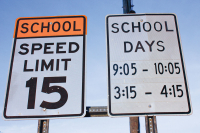Sales tax on the ballot in Swain: If passed, money would go toward school construction
Swain County voters are being asked this election whether they want a quarter-cent sales tax increase to help pay for school construction.
The quarter-cent sales tax would bring in roughly $250,000 a year and would pay for a $2 million expansion of East Elementary. The additional classrooms would let the school do away with “dilapidated” modular units that currently serve as classrooms to handle overcrowding, said County Manager Kevin King.
The student body at East Elementary has grown by more than 40 students in the past five years.
Last year, West Swain Elementary added eight new classrooms, at a cost of about $1.8 million, and now it’s East Elementary’s turn.
County commissioners have little choice when it comes to school construction. The state doesn’t build schools — that job is left to the counties.
So the choice for Swain voters is not whether to build an addition at East Swain but merely how they want to pay for it.
Related Items
If the sales tax doesn’t pass, school construction must be paid for with property taxes. Given the county’s dire budget straits, a property tax increase to pay for the school construction seems highly likely unless voters approve the sales tax.
“I would rather see the sales tax,” said Swain School Superintendent Bob Marr. “Then you are spreading it over a wider audience of people who are bearing the burden of taxation than just the people that own property in Swain County.”
Commissioner Donnie Dixon said he supports the sales tax increase, particularly since it will tax visitors to Swain County, not just residents.
If the referendum fails there’s a third option to pay for the school construction: cutting the county’s budget in other areas to come up with the money. But that isn’t likely given the cuts that were already made to weather the recession.
At a meeting just last month, commissioners said that further cuts to the county budget would be difficult and unpalatable.
A day late
The quarter-cent sale tax on the ballot in Swain will no doubt come as a surprise to many voters when they walk into the polling booth.
County commissioners voted unanimously in February to put the sales tax for schools on the ballot come November.
But since that quiet and uneventful decision, it has been vastly under-publicized. School leaders nor county commissioners haven’t talked it up. Local papers have been devoid of stories on the issue. Few even seem to be aware of it.
“I don’t think we will get it passed because people don’t know about it,” said Gerry McKinney, a Swain County school board member. “I just don’t think we got enough word out on it.”
McKinney thinks people would vote for it if they realized it was going toward schools.
“People do support education,” McKinney said.
But unfortunately, the question on the ballot won’t mention the words “schools” or “education.”
“It don’t say it on the ballot,” Marr said.
Instead, the question simply asks voters whether they want a quarter-cent sales tax increase.
Based solely on that question — do you want higher sales taxes — most would probably answer no, Marr said.
“People don’t want no more taxes,” Marr said.
That’s the personal opinion of Commissioner David Monteith, even though he voted with the rest of the county commissioners to put the sales tax on the ballot.
“I have no problem sending this to the public and letting the public vote on it,” said Monteith. “My personal opinion is I don’t want to pay any more taxes.”
But, fellow commissioner Steve Moon said it is the better option.
“If it’s going to help the schools, then I think we should (do it),” Moon said. “This is a minor concession.”
Despite support for the tax increase from most of the commissioners, little has been said or done to let people know about the issue.
There should have been a proactive public information campaign to get the word out about the sales tax, McKinney said.
“That has been kind of frustrating to me,” McKinney said about the lack of publicity. “I wanted to go out and talk to the community and churches and things like that.”
But, a coordinated effort never manifested, in part simply due to no one stepping up and taking the lead, and in part because they thought the wording on the ballot would sufficiently explain what the vote is about.
School leaders said they were surprised several weeks ago when they first saw the wording for the vote on sample ballots.
“Originally, we thought the wording might be different. We thought it would say the sales tax would be dedicated for school construction,” said Sam Pattillo, director of auxiliary services for Swain Schools. “It surprised us when the ballot came out and didn’t say ‘directed to school construction.’”
Marr said school advocates have been trying to get their word out during the past month in a last-ditch effort.
“It is never too late,” he said.
Unfortunately, the State Board of Elections stipulates the sales tax wording on the ballot, not counties — and it can’t say what the sales tax revenue will be used for.
The reason: what one set of county commissioners promise to spend the sales tax money toward isn’t necessarily what future commissioners will spend it on.
Today’s commissioners can publicly declare their own intentions to spend the sales tax money on schools. But, they can’t promise what commissioners in the future would do and thus can’t make that promise on the ballot.
In hindsight, Marr said, there should have been a better public campaign to drum up support for the sales tax, although he doesn’t know who would have stepped up to do it.
The school system can’t expend its own money or resources — not even printing out fliers on the school photocopier — because county and state resources can’t be spent on political purposes. School employees can’t advocate for the sales tax vote while on the clock or use their school email addresses to send messages asking people to support the tax vote.
Few counties in the state have successfully gotten voters to pass a sale tax increase. The success rate is as low as one in four.
Since 2007, 56 counties in North Carolina have held ballot referendums, hoping that voters would voluntarily approve a tax increase — some counties had a second go at a vote after it failed the first time. Only 23 counties have been successful, however.
Haywood County was one of the first in the state to get a quarter-cent sales tax approved by voters back in 2008. The county pitched the tax as a way to pay for a construction master plan at Haywood Community College.
Community college supporters launched an aggressive and visible campaign months ahead of the election to lobby voters for its passage, and county commissioners also spoke up in favor of the sales tax at every turn — citing a sales tax as a better option that property taxes since it gets tourists and visitors rather than just local property owners.
Buncombe County voters earlier this year passed a quarter-cent sales tax to fund construction at its community college, AB Tech. AB Tech supporters mirrored the successful strategy in Haywood, including the creation of an official political action committee.
In the works
An addition for East Elementary has long been part of the school construction master plan. The number of students has gone up steadily, and they eventually outgrew the school building a few years ago.
Modular classrooms were brought in as a stopgap measure, but it is time to get students out of the modulars and in a real school building, McKinney said.
Swain has two elementary schools: East and West. Until recently, West Elementary was overcrowded and also holding class in modulars.
A $1.8 million expansion at West has now solved that school’s problem with eight new classrooms. Now, it is East’s turn, McKinney said.
When school leaders met with the county in January to talk about their school construction master plan, County Manager Kevin King was the one to suggest a quarter-cent sales tax.
The matter was voted on “kind of almost last minute,” King said.
The measure passed quietly with no conversation among the commissioners, according to minutes from the Feb. 13 meeting.
To pay for the expansion at West Elementary, the county simply took out a loan and paid for it from its regular coffers. It got an expansion first because its modulars were older.
The growing student body in Swain is perhaps surprising given the 12 percent unemployment rate the county is struggling under. But, the hundreds of new jobs added at nearby Harrah’s Cherokee casino during the past few years has provided a source of employment for families who in turn end up with kids in the school system.
“The casino employs a lot of people out of Swain County so that has added to people coming back here or moving here,” McKinney said. “Our population of students from Cherokee has also grown.”
Indeed, East Elementary has a large number of students from Cherokee. Although the Eastern Band of Cherokee Indians has its own school system, enrolled members of the tribe that live on the Swain County side of the reservation can chose whether to go to school in Cherokee or come over to Swain County.
For many Cherokee families, East Elementary in Swain is closer than their own elementary school on the reservation. And many parents attended East Elementary and send their own kids there out of tradition, even though Cherokee recently built a brand-new state-of-the-art school.
Like at West Elementary, the expansion at East Elementary would add eight classrooms. It has not yet been designed but would likely cost about $2 million, Pattillo said. If the school were given the green light to start on the project today, it would take nearly two years until it was completed, Pattillo estimated.
Long-range school plan
School leaders hope to hurry up and get the expansion at East Elementary out of the way. They have bigger fish to fry in coming years: namely building a new high school.
The school master plan calls for a new high school in the next several years. The middle school would then move to the current high school.
The high school has seen student increases of its own during the past decade.
The high school faces a unique problem — it can’t always simply make class sizes bigger.
“When you are offering a calculus class, you may only have 10 or 12 people, but you still need to offer it,” McKinney said.
The high school population has also grown thanks to a lower dropout rate now compared to five years ago.
But, the county must wait until at least 2018 before it even considers taking on more school debt. Swain County is currently paying off bonds for past school construction, and the main bond will be paid off in 2018, freeing up $500,000 a year that can be used to help pay off the debt service on a new high school building.
But, it still won’t be enough so the county will have to find other ways to pay for a new high school.
“Even that part won’t make a dent in a new school building; however at some point in the future, that need needs to be addressed,” King said, adding that it cannot be ignored for long. “We are planning for the future.”
If the middle school moves into the existing high school, the existing middle school could serve several other uses, Pattillo said. It wouldn’t happen for another 10 years, but one use Pattillo already envisions is a new site for Pre-Kindergarten.
But, East Elementary has to be checked off the list before starting on the new high school.
“We got to keep plugging along,” Pattillo said.









